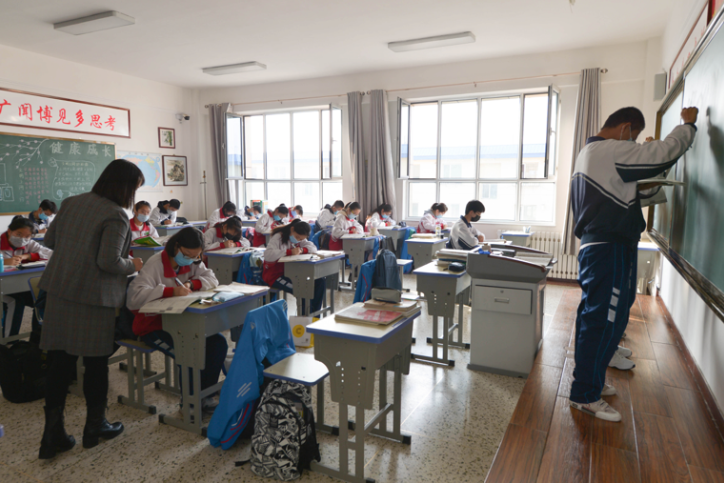Covid-19 broke out in China at the beginning of 2020. Initially, the novel coronavirus spread at an incredibly high speed, and strict measures for epidemic control followed in the Chinese mainland. In this initial phase, many people were caught off-guard because they were away from home or work due to the Spring Festival holiday. In order to deal with the alarming increase of cases, the Government introduced lockdowns and restrictions on travel that seemed necessary, but that also led to great challenges for the Chinese people. In this essay, we focus on the challenges that students and teachers faced. Campuses and schools were closed due to the lockdowns so that both teachers and students had to adapt to learning and teaching online. Battling with the urgent tasks of containing the epidemic was the priority as February passed into March. The reopening of the schools was nowhere in sight. What is more, the college entrance examination, considered to be a turning point in the destiny of young Chinese men and women, was postponed for a month. Which aspects of education in China were affected by the Covid-19 and what were the different scales at which such problems manifested themselves? We compare the effect of Covid-19 on students to the earlier experience of SARS in 2013. Finally, we aim to make available the concerns of Chinese scholars with regard to the education sector as a whole under the pressure of epidemics, hoping that we can learn from our present so as to make sufficient preparations for the future.
Impact on primary and secondary education
Impact on learning
The epidemic led to the total suspension of classes in primary and secondary schools. Following an appeal from the Ministry of Education—”Suspended class, Ongoing learning”—the online courses launched by schools came into full swing. However, there are some serious concerns about the impact of online learning on educational goals of students. First of all, the modality of teaching online differs from offline teaching. For one thing, online courses rely on online teaching platforms and network systems. Once the network or the platform breaks down, the courses tend to be interrupted. For another, teachers are used to the traditional way of teaching, which rely on physical proximity to each other in a classroom setting. Online teaching is a new form for many teachers and one cannot assume that virtual classrooms are identical to traditional classroom interactions. Secondly, it is hard to motivate students to immediately cultivate the kind of attention required for learning in a virtual classroom environment. This problem is exacerbated for primary and secondary school students, whose phase of psychological development has not necessarily reached the needed level of single-minded concentration without the incentives which come from actual physical interactions, body language, and peer support. The supervision of the learning process of each student is weakened as teachers are not able to observe students as they interact with each other and with the teacher in a collective virtual environment. Sometimes students may be tempted to leave the computer during the class or do other things like play games, watch dramas, and so on. One of the biggest social networks provider in China, Weibo, provides school students with information and suggests tricks they can use to skip class without teachers noticing their absence. In addition, the inspection of homework by teachers and the vigilance with regard to individual student’s progress cannot be monitored in the same way through online teaching as is normal in the classroom for Chinese schools. These conditions are likely to increase inequalities in student performance; those students most in need of supervision might suffer the most. Hence, after schools reopen, the “Matthew effect” is likely to kick in among the students. That is, during the initial period of resumption, students with better learning outcomes might have better performance than before, while students with poor grades might get even lower grades than in former semesters. As teaching activities begin to go back on track, this difference should gradually return to a normal scale. However, the long-term effects of these disruptions during the pandemic need systematic study and documentation.
Impact on further education
In China, the spring semester normally starts in February and ends in July, lasting about 5 months. Affected by the epidemic at the beginning of March, Hong Kong issued a notice of “one year of repetition for all primary school students in Hong Kong.” According to the latest news from Xinhua News Agency, starting from mid-April, the schools will be fully reopened under strict supervision for any signs of reappearance of the corona virus1. Usually, half of the semester and teaching activities are completed in April. This year, due to the epidemic, even if classes are resumed, it will be impossible to maintain the same rhythm as before. Schools are likely to extend the semester, or make up classes through summer vacation, in order to guarantee that students can catch up with the pace of learning in the following semester. Furthermore, according to the latest news, the college entrance examinations are likely to be postponed by a month to July 7 and 8 2. Whether the postponed date can be a remedy for the time wasted amid the epidemic remains an open question. It is likely that the change in the learning and teaching environment due to the coronavirus this year will result in a generally low score or an increase in the number students who will need to repeat the last year of high school, in order to get better grades, as happened during the SARS epidemic in 2013.

Graduating students attend a class at Hohhot No. 6 Middle School in Hohhot, north China’s Inner Mongolia Autonomous Region, March 30, 2020. (Xinhua/Xu Qin)
Impact on the educational training sectors
Online and offline courses
The situation created by Covid-19 seems to be both an opportunity and a challenge for China’s large and small education and training institutions. Even under normal circumstances a large number of school students opt for after school tutoring. Now the demand for online tutorials has escalated. According to the report from People’s Daily online, the number of searches for the keyword “online education” via the search engine Baidu soared from 300 on January 17 to 5,000 on February 10 3, indicating a huge demand for online courses. In the early days of the outbreak, NetEase Cloud Classroom, one of China’s largest online education platforms, announced free access to NetEase courses for elementary and middle school students from Hubei until the epidemic could be brought under control. NetEase’s actions of transporting and donating goods from all over the country to Wuhan for supporting the people there received considerable press in China and became a hot topic of discussion on the Internet. The public was full of praise for the altruistic behavior of the company in the emergency. Simultaneously, however, the epidemic was seen as an opportunity for this online provider to stimulate demand for online after school courses. Combined with the call for “non-stop learning,” a large number of parents purchased online tutoring courses for their children to enrich their study time at home. Previously, most of the training institutions offered courses both online and offline, but because of the epidemic and the anxieties created about children’s performance in exams, demand for online courses surged. Compared to the boom of online courses, the offline educational institutions that were providing additional resources to students through after school courses now confronted a difficult situation. Although some small offline training institutions have been forced to switch to an online mode to survive, a large number of these have had to shut down due to the broken capital chain. However, on the whole, the education and training industry is still one of the most optimistic industries in China. And NetEase Youdao also announced its investment in the K12 educational intelligent hardware platform, decibel factory 4.

A graduating student gets temperature checked at the entrance of the school building of Hohhot No. 35 Middle School in Hohhot, north China’s Inner Mongolia Autonomous Region, March 30, 2020. (Xinhua/Lian Zhen)
Development of the intelligent platforms
The development of online courses at a large scale has exposed many shortcomings of live web-casts or online education platforms. It is clear that the relevant functions to sustain teaching, such as the stability of the platforms, the presentation of teaching materials, and supervision during the class, have to be improved. Yet, most of the current live broadcast platforms are made for publicity. These enable Internet celebrities to sell products, or, for the game anchors to air game-playing modes. Therefore, there are too many functions that are bundled which are not suitable for the environment of classroom teaching. These include, sending virtual gifts to the anchor, or the automatic over-beautification of the anchor’s face. All these functions can cause distractions in class, which may make the students and teachers lose their focus. There is an urgent need for a professional platform for online courses that would not only optimize the interaction between teachers and students, but also enhance the user experience.
In view of the contingencies created by the shift to online learning on a massive scale, many intelligent office software were introduced into online education management. For instance, Alibaba’s APP, Dingding, was recommended by UNESCO for its powerful functions as one of the best software for management of educational goals during the quarantine. In China, Dingding had earlier received very poor ratings by a large number of primary and middle school students who were using the mobile phone software store, because of its strict control system (i.e., if the overall rating is below three points, the APP will be removed from the shelves). This caused a crisis of confidence and massive efforts were made by the company to reestablish its reputation throughout the network. Dingding offered a sincere “apology” to the primary and middle school students nationwide, which became the focus of a heated discussion over the relative merits of Weibo and Dingding. This incident also reminded the users of education platforms that they can introduce the merits from other intelligent office or management software to improve their platforms.
Impact on higher education
Employment issues
In China, campus recruitment is major means for students to find employment. Campus recruitment is divided into autumn recruitment and spring recruitment. The autumn recruitment is generally aimed at students who have no plans to go for higher degrees, and want to work directly after graduation. Spring recruitment is aimed at those students who are otherwise accomplished, but performed poorly in postgraduate entrance examinations and hence need to find employment. For prospective graduates in 2020, the adverse impact of the epidemic on employment prospects is a matter of great concern. For students who participated in the autumn recruitment, whether they can graduate as scheduled becomes an important factor in deciding whether they can successfully enter the job market. Meanwhile, domestic and large enterprises have been adversely affected by the epidemic and whether demand for students as employees will accordingly shrink is causing great uncertainty.
For students waiting for the spring recruitment, this period is also very difficult. The spring recruitment was canceled due to Covid-19. Whether it will be reorganized after the full reopening of schools depends on too many unknown factors. Most of the students waiting for the spring recruitment either participate in the postgraduate entrance examination or take the public examination. Nevertheless, due to the epidemic, the timing for these tests has also become uncertain. It is feared that China may experience the largest spurt in rates of graduate unemployment in the last twenty years.
Impact on studying abroad
According to news from the Ministry of Education, there are about 1.6 million overseas Chinese students, and currently there are still about 1.4 million abroad 5. It had seemed earlier that the interest in studying abroad among Chinese students was on the rise with 413,900 Chinese studying abroad in 2013 and 662,100 in 2018 6. The countries to which students go for higher education has diversified over the last few years. 7. The impact of the epidemic on the overseas study programs remains uncertain because much will depend on the decisions of universities in other countries to invest in higher education as well as their policies on migration. The global outbreak of the epidemic may lead to the postponement of enrollment of foreign students in many universities posing a dilemma for those students who have already been admitted. Government-sponsored overseas education is also greatly affected, including joint training of students and visiting scholars. Since the trajectory of the coronavirus remains uncertain many programs of training that were premised on global partnerships might need to be suspended.
In summary, the delay of graduation and rise of unemployment is inevitable. Overseas students who have already found a job, similar to domestic students, also face the risk of delayed entry into the work force or the cancellation of their positions. The long-term effects of such delays and uncertainties on the students who were accustomed to thinking that higher education will give them a secure future will need to be carefully studied in the coming years and plans for mitigation of these hardships will be an important project for the government and the universities alike.
The impact on postgraduate education inland
Despite the increasing interest in studying abroad, the poor management of the Covid-19 pandemic in many countries has made some families look at the prospect of overseas studies for their children more critically now. Accompanied by the pressures for adequate jobs mentioned above, the prospective graduates might prefer to take postgraduate admission examination, increasing pressure on domestic graduate admissions. The number of participants in the postgraduate entrance has exceeded 3.41 million in 2020 8. The epidemic will undoubtedly make the situation worse next year.
Apart from the students, the Ministry of Education and the colleges are under great pressure as they plan for the organization of examinations for the postgraduates, the written tests that have to be administered to such large numbers of students, and little experience with online testing methods. The biggest challenge is going to be how to alleviate the unemployment problem for the educated youth and restore faith in the Chinese economy.
Conclusion
Although the epidemic in China seems to have subsided, its impact on education is irreversible. Students will have to face delays in graduation and the market demand for educated youth is in decline. Earlier certainties about where to study and when to enter the job market have disappeared. Teachers and students need to adapt to a new teaching mode as there is no certainty about the trajectory of this virus or when new kinds of diseases may disrupt established patterns in education. Clearly, the schools need to embark on new plans for the next year. The severity of this epidemic has also revealed the shortcomings of the current educational institutions. For example, despite the booming development of the Internet, only few teaching institutions including schools and universities had cultivated the abilities to incorporate online teaching and learning in their curricula. Shortages of apps or software and skyrocketing unmet demands for these resulted in significant disruptions in teaching activities. Tragically, the situation led to the closure of some reputed offline education companies. In the future, educational institutions need to keep abreast of new technologies in teaching and be prepared for the kind of disasters that put the future of education in jeopardy. Yet there are new opportunities to rethink how the growth of online educational platforms might be productively used in preparing for this uncertain future.
Notes:
[1] Xinhua News Agency. Schools begin to reopen in China amid strict measures. March 31, 2020. Accessed on April 3, 2020. http://en.people.cn/n3/2020/0331/c90000-9674230.html.
[2] Xinhua News Agency. China’s national college entrance exam postponed for one month. April 1, 2020. Accessed on April 9, 2020. http://en.people.cn/n3/2020/0401/c90000-9674814.html
[3] People’s Daily online. China’s online education sector booms as epidemic keeps students out of schools. March 12, 2020. Accessed on April 9, 2020.http://en.people.cn/n3/2020/0312/c90000-9667372.html.
[4] Sanyi Life. NetEase Youdao invests in a decibel workshop, and the K12 field is once again laid out. March 27, 2020. Accessed on April 9, 2020. https://new.qq.com/omn/20200327/20200327A0Q5KB00
[5] CCTV 4. Data reveal the current status of Chinese students abroad. April 4, 2020. Accessed on April 9, 2020.
https://baijiahao.baidu.com/s?id=1662989169416100083&wfr=spider&for=pc
[6] China Education News. Studying Abroad and Cultivating Construction Talents with International Vision. September 27, 2019. Accessed on April 9, 2020. http://www.moe.gov.cn/jyb_xwfb/s5147/201909/t20190927_401309.html.
[7] D. Li. Diversity is the trend of studying abroad and the choice of Studying Abroad. Study Abroad, 2018, no. 22, pp. 2.
[8] Guangming Daily. What happens if the postgraduate examination encounter an epidemic situation? March 3, 2020. Accessed on April 3, 2020. http://www.moe.gov.cn/jyb_xwfb/s5147/202003/t20200303_426788.html
Cite As: Xiao, Chunchen and Yi Li. 2020. “Analysis on the Influence of Epidemic on Education in China.” In “Covid-19 and Student Focused Concerns: Threats and Possibilities,” Veena Das and Naveeda Khan, eds., American Ethnologist website, May 1 2020, [https://americanethnologist.org/features/collections/covid-19-and-student-focused-concerns-threats-and-possibilities/analysis-on-the-influence-of-epidemic-on-education-in-china]
Chunchen Xiao is the Academic Director at Harbour Education. chunchenxiao@cas-harbour.org
Yi Li is an Academic Specialist at Harbour Education. ashlee@cas-harbour.org




